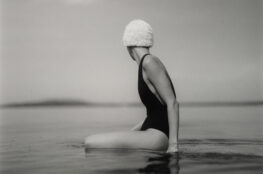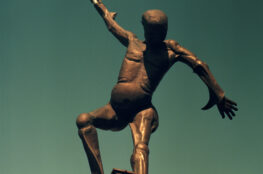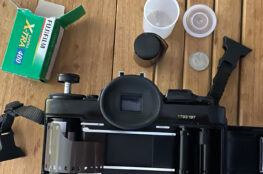The english version can be found here.
Wann wird ein Foto zu einem Foto? Gedanken von Andrew K. Thompsons
 Ein Freund schrieb mir eines Sonntagmorgens die folgende Frage: „Wann wird ein Foto zu einem Foto?“. Wie viele andere habe ich den Prozess der Aufnahme eines Fotos immer als selbstverständlich gesehen. Ich reichte meine Kamera aus und mache ein Foto. An den Prozess dazwischen habe ich nie viele Gedanken verschwendet. Die Anfrage zwang mich dazu innezuhalten und über den Moment, in dem Licht eingefangen und zu etwas Permanentem gemacht wird, nachzudenken. Nachdem ich mich durch die Bücher zur Geschichte der Fotografie in meiner Bücherei gewälzt hatte denke ich, dass mir die Antwort nun klar erscheint.
Ein Freund schrieb mir eines Sonntagmorgens die folgende Frage: „Wann wird ein Foto zu einem Foto?“. Wie viele andere habe ich den Prozess der Aufnahme eines Fotos immer als selbstverständlich gesehen. Ich reichte meine Kamera aus und mache ein Foto. An den Prozess dazwischen habe ich nie viele Gedanken verschwendet. Die Anfrage zwang mich dazu innezuhalten und über den Moment, in dem Licht eingefangen und zu etwas Permanentem gemacht wird, nachzudenken. Nachdem ich mich durch die Bücher zur Geschichte der Fotografie in meiner Bücherei gewälzt hatte denke ich, dass mir die Antwort nun klar erscheint.
Teil Eins:
- Das Wort „Fotografie“ setzt sich aus den griechischen Wörtern φωτός (photós) für „Licht“ und γράφειν (graphein) für „Malen“ oder „Zeichnen“ also „Zeichnen mit Licht“ zusammen
- Die Kamera Obscura ist die Mutter aller Kameras und soll schon Inspiration für altsteinzeitliche Höhlenmalerein gewesen sein. Die erste Camera Obscura wurde um 500 v. Chr. Beschrieben.
- 1826 erfand Nicéphore Niépce einen Weg um ein mit einer Camera Obscura erzeugtes Bild zu fixieren. Früher sprach man bei Fotografie also von „der Kunst einen Schatten zu fixieren“.
- 1927 schrieb László Moholy-Nagy in seinem Essay „Fotografie ist Lichtgestaltung“ , dass das Hauptinstrument der Fotografie nicht die Kamera sondern die photosensitive Schicht sei. Jeder fotografische Film und jedes fotografische Papier hat eine oder mehrere Schichten aus diesem Material die die Formen des auftreffenden Lichts aufzeichnet.
- 1947 schaute ein junger Yves Klein am Strand in den Himmel und stellte sich vor, mit seinem Finger seinen Namen in die Wolken zu schreiben. Er erklärte: „Der blaue Himmel ist mein erstes Kunstwerk“.
- Ein Gedächtnispalast ist ein ausgedachter Ort im eigenen Kopf an dem grafische Abbildungen von Dingen an die man sich erinnern möchte abgelegt werden.
Teil Zwei:
- Waren altsteinzeitliche Höhlenmaler wirklich Fotografen? Haben sie das Licht das sie gesehen haben gezeichnet? Ist die Abbildung von Licht in einer Kamera Obscura eine Fotografie?
- Ist schon das Ausrichten einer Kamera auf ein Subjekt eine Fotografie? Muss der „Fotograf“ den Auslöser drücken? Muss eine Belichtung stattfinden, dass aus dem Ausrichten eine Fotografie wird oder reicht schon die Inszenierung der Welt in der Phantasie? Kann man durch die Ausrichtung einer Kamera eine Fotografie erstellen so wie es Yves Klein den blauen Himmel sein Kunstwerk nannte? Füllt er also einen Gedächtnispalast mit atemberaubenden Bildern?
- Wenn ein „Fotograf“ Licht auf eine lichtempfindliche Oberfläche bringt, dann diese Belichtung nicht entwickeln oder fixieren kann, bezeichnet man diese Belichtung dann trotzdem als Fotografie? Und was ist wenn diese Belichtung im Kopf des „Fotografen“ gespeichert ist?
Wenn man in den Himmel sieht kann man die Unterschrift von Yves Klein nicht sehen. Wenn sich in eine Kamera Obscura setzt und den Tag vergehen lässt wird man keine Aufzeichnung des Zeitablaufs. Und auch wenn man einen Gedächtnispalast voll mit faszinierenden Bildern hat wird man diese niemandem zeigen können. Ich denke, dass alleine das Ausrichten einer Kamera keine „Fotografie“ erzeugt, sondern eine Erinnerung die dann vielleicht später zu einer Fotografie wird. Die Erinnerung und Fotografie sind in vielen verschiedenen und interessanten Arten verbunden, dennoch ist die Erinnerung an eine Szene durch einen Sucher gesehen sicherlich keine Fotografie.
Wenn ein Fotograf einen Film belichtet entsteht ein latentes Abbild. Wenn der Film allerdings nicht richtig entwickelt oder fixiert wird es nie zu einer Fotografie. Wenn die Entwicklung und Fixierung erfolgreich abgeschlossen wurde entsteht letztendlich eine Fotografie, genauer gesagt ein Negativ. Dieses Negativ wird dann genutzt um ein Positiv auf einem Papier zu erzeugen. Nach erfolgreicher Entwicklung und Fixierung ist auch dies eine Fotografie.
Das „fotografische“ Abbild erschien für hunderte Jahre in den Camera Obscuras, konnte aber erst Mitte des 18ten Jahrhunderts fixiert, und somit mehr als eine Erinnerung werden. Die Möglichkeit der Fixierung entstand während der industriellen Revolution als Wissenschaftler, Alchemisten und Andere lichtempfindlichen Emulsionen entdeckten, mit diesen experimentierten und sie letztendlich auch verbesserten. Eine Fotografie ist also eine Arbeit in drei Schritten. Eine Belichtung muss stattfinden, diese muss dann entwickelt und fixiert werden.
Die Beziehung zwischen der belichteten Emulsion und der Fixierung braucht aber auch eine kleine Fußnote. Die Möglichkeit der Fixierung war ein Meilenstein und erlaubte den Malern die Bilder der Camera Obscura zu Fotografien werden zu lassen. Das könnte einen also zu der Annahme verleiten, dass ein Bild fixiert sein muss um eine Fotografie zu sein. Was ist aber mit Fotografen wie Sigmar Polke, Phil Chang oder DM Witmann die ihre Bilder absichtlich nicht fixieren und somit dem Bild ermöglichen mit der Zeit zu verblassen? Ihre Arbeiten beginnen klar als Fotografien aber verändern sich mit der Zeit.
Ich finde Moholny-Nagys Zitat über die lichtempfindliche Schicht als Hauptinstrument als Schlüssel für die Antwort auf die Frage. Ich denke, dass ein Foto zu einem Foto wird, wenn die lichtempfindliche Schicht aktiviert wird. Für mich ist ein Foto keine Abbildung von einem Subjekt oder einem Objekt. Auch ein Chemigram kann eine Fotografie sein, genau wie ein abstraktes Bild von zufällig positionierten Formen ähnlich eines Fotograms. Es kann natürlich auch etwas Normales wie ein Abzug eines Negativs sein. Sobald die lichtempfindliche Schicht durch Belichtung und dann durch Chemie aktiviert wurde ist eine Fotografie entstanden.
Mehr von Andrew gibt es auf seiner Webseite.
At what point does a photo become a photo? Thoughts of Andrew K. Thompson
 A friend DM’ed me one Sunday morning with this question, at what point does a photo become a photo? Like many, I had taken the process of making photographs for granted. I point my camera, I make a photograph and not much thought was given to rest of the steps. His prompt required me to pause and reflect on the moments when light is captured and then becomes permanently fixed. After rummaging through my library of photo history books, I believe the answer was made clear to me.
A friend DM’ed me one Sunday morning with this question, at what point does a photo become a photo? Like many, I had taken the process of making photographs for granted. I point my camera, I make a photograph and not much thought was given to rest of the steps. His prompt required me to pause and reflect on the moments when light is captured and then becomes permanently fixed. After rummaging through my library of photo history books, I believe the answer was made clear to me.
Part One:
- 1. The word “photography” is derived from the Greek words φωτός (phōtos), “light” and γραφή (graphé) „representation by means of lines“ or „drawing“, together meaning „drawing with light“.
- 2. The Camera Obsucra is the foundation of all cameras. The earliest Camera Obsuca is believed to have inspired Paleolithic cave paintings. The earliest written observations of a Camera Obsucra are dated around 500 BCE.
- 3. In 1826, Nicéphore Niépce was the first inventor to permanently “fix” an image created by a Camera Obsucra. As a result, an early description of photography was “the art of fixing a shadow”.
- 4. In 1927, László Moholy-Nagy wrote in his essay Photography Is Design with Light, “The main instrument of the photographic process is not the camera but the photosensitive layer.” All photographic film and paper has a layer(s) of photosensitive materials that records the patterns of light that it is exposed to.
- 5. In 1947 while lounging on a beach, a young Yves Klein looked up at the sky and imagined signing his name near the clouds. “The blue sky is my first artwork”, he declared.
- 6. A Memory Palace is an imaginary location in your mind where you can store mnemonic images. The creator of a Memory Palace uses visual representations (mnemonic images) for each subject they want to remember.
Part Two:
1. Were Paleolithic artists really photographers? Where they drawing the light that they saw? Is the projection of light within a Camera Obsucra a photograph?
2. Is the process of pointing a camera at a subject taking a picture? Does this “photographer” need to press the shutter button? Does an exposure need to happen for the gesture of pointing a camera to become a photograph or can it just be a memory created by framing the world in a specific way? Is the photographer who points the camera toward a subject but does not expose the film creating a photograph in the same way that Yves Klein signed the sky and declared his artwork? Is he filling his Memory Place with visually stunning images?
3. If a photographer exposes light to light-sensitive materials but fails to develop and fix that exposure, is that exposure still a “photograph”? Even if the memory of the image is fixed within the photographer’s Memory Palace?
If you look to the sky you will not see Yves Klein’s signature. If you watch the day pass while sitting inside a Camera Obsucra you will not have a time-lapse photograph. Even if you have a fully realized Memory Place filled with stunning mnemonic images you will not have a portfolio of photographs to show. I believe that pointing a camera at the world does not make a “photograph”. It instead creates a memory that may or may not become a photograph. Photography and memory are bound in interesting ways but the memory of an image viewed through a lens is certainly not a photograph.
Once the photographer exposes the film a latent image has been rendered. Yet, if the exposed film is not properly developed, is lost and is not fixed, it never becomes a photograph. But if the film has been carried to full term and properly fixed, then it is indeed a photograph, but more specifically a negative. This negative is then used to create a positive photograph on paper, and as long as the positive image is fixed then it too is a photograph.
The “photographic” image has occurred for centuries in Camera Obscuras but it was until the mid 1800’s that the shadows could be “fixed” and thus become permanent, more than a memory. The ability to fix an image arrived during the Industrial Revolution when scientist, alchemist and professional men of leisure repeatedly experimented with, discovered and eventually refined photosensitive emulsion. But a photograph is a three-part process, first the exposure must be made, then the emulsion must be developed and finally the exposed emulsion must be fixed.
Yet, the complex relationship between the exposed emulsion and it being fixed requires an asterisk. Being able to fix the image was the major break though that allowed painters using Camera Obscuras to become photographers. This would lead one to, rightly, believe that the image must be fixed to become a “photograph”. But what about photographers who purposely do not fix their photographs and allow the images to fade over time, like Sigmar Polke, Phil Chang or DM Witman? Their work clearly starts out as a photograph but slowly changes over time.
I hold Moholy-Nagy’s quote about the “photosensitive layer” being the “the main instrument of the photographic process” as the key to understanding this topic. I believe that a photo becomes a photo when the photosensitive layer is activated. I do not define the photo as a representation of a subject or an object. The photograph can be non-representational like a chemigram, it can be abstract renderings of placed objects, like a photogram or entirely representational like a negative to a positive print. But once the photosensitive layer as been activated by light and then by chemistry a photo has been made.
You can see some of Andrew’s work and thoughts on his website.




